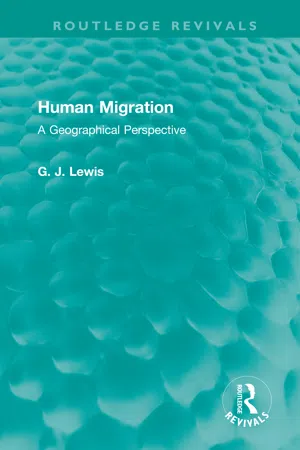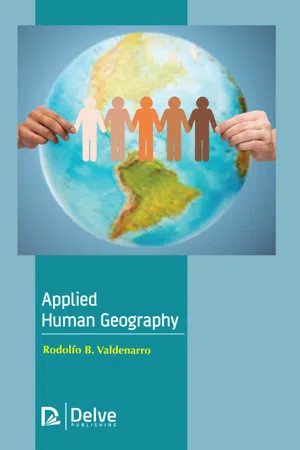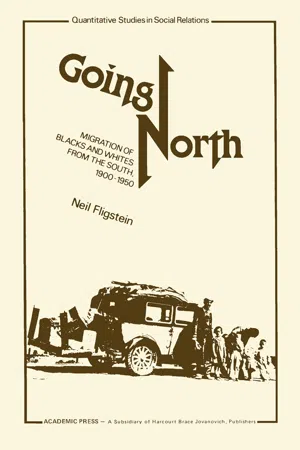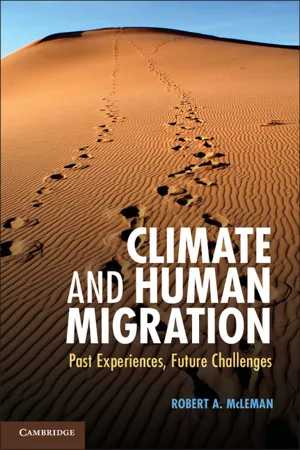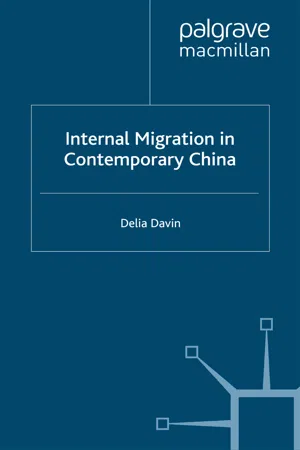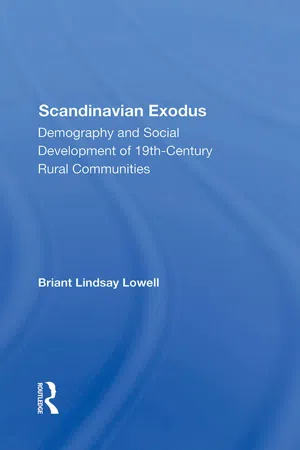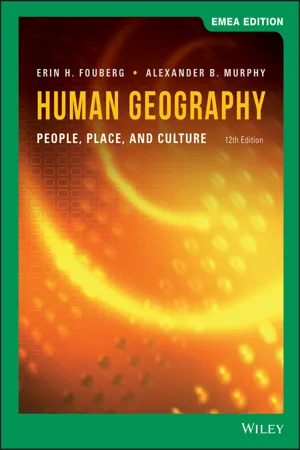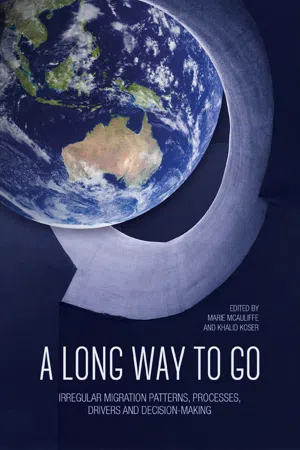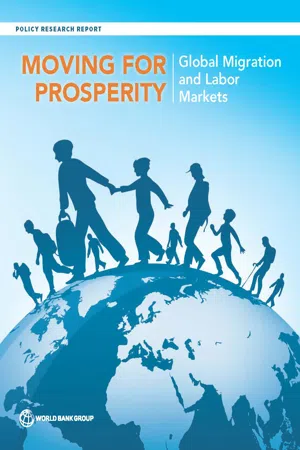Geography
Causes of Migration
Causes of migration refer to the factors that drive people to move from one place to another. These can include push factors such as conflict, poverty, and environmental degradation, as well as pull factors like economic opportunities, better living conditions, and family reunification. Understanding these causes is essential for analyzing patterns of human movement and their impacts on both origin and destination areas.
Written by Perlego with AI-assistance
Related key terms
1 of 5
10 Key excerpts on "Causes of Migration"
- eBook - PDF
- Joseph P. Stoltman(Author)
- 2011(Publication Date)
- SAGE Publications, Inc(Publisher)
Migration involves people leaving a place (origin) and arriving at a new place (destination) under varying circum- stances. Migration is not pursued in isolation because the decision to migrate is linked to numerous push and pull factors. If City A has 30% unemployment and City B has a 5% or lower unemployment rate, it seems apparent that the economic hardship would act as the push factor to encourage people to leave City A and the opportunity (low unemployment rate) would act as the factor pulling people toward City B. There are intervening obstacles, which may impede migration, and that discussion is presented later in the chapter. Wherever there are movements of people, there are consequent demographic, social, and economic changes with spatial implications. Geographers study the spatial nature of movement and seek to derive the motives that people have for moving. The geographic contexts for 231 232 • HUMAN GEOGRAPHY migration occurs in multiple forms, such as people fleeing regions experiencing military conflicts, land-poor people settling new lands that are available for agriculture, or the mass migrations of Europeans moving to the Americas during times of religious, economic, and political repres- sion. These movements represent humans' quest for new beginnings and illustrate the migration phenomenon and restructuring of populated places in the world. Geography as a spatial discipline synthesizes and analyzes migration at different scales in the context of a place of origin and a place of destination. What Is Migration? What is migration? It can be defined spatially, based on where and how long individuals change their residential address domestically or internationally. Is the move perma- nent or semipermanent? Is it migration if a person moves from downtown Los Angeles to Hollywood? How about Mr. - eBook - ePub
Human Migration
A Geographical Perspective
- Gareth J. Lewis(Author)
- 2021(Publication Date)
- Routledge(Publisher)
7
Causes of Migration
DOI: 10.4324/9781003183051-7Unlike birth and death, migration has no physiological component; rather it is a response by humans to a series of economic, social and political stimuli within the environment. Such stimuli take the form of attractiveness of a location which can be generated by changes within the environment or in a person’s value system. If, as a result of these changes, the person becomes dissatisfied with his home location, then a desire to migrate will be generated. The strength of the desire to migrate, and whether it is fulfilled or not, will vary according to the needs of the individual, the constraints upon him and the strength of the dissatisfaction (Pryor, 1975b). For example, according to Lord Eversley the vast exodus of labourers from the rural districts into the towns of England and Wales during the nineteenth century was due not only to ‘greater prosperity and the general rise of wages in the manufacturing and mining districts’, but also ‘to a growing disinclination to farm work among labourers in rural districts, to the absence of opportunities to them of rising in their vocation, and to a desire for the greater independence and freedom of life in towns’ (Eversley, 1907, 280). Within this listing of the factors explaining migration, two undifferentiated sets of forces appear to exist: on the one hand, there are stimuli to migrate created by changes within the environment and, on the other, changes in the personal motives of the individual.The analysis of migration causes has attracted considerable attention, in particular the decision to migrate, the decision where to migrate to, and the criteria involved in such decisions. Most of the emphasis of the research, however, has been on the latter aspect of the causal nexus (Cebula, 1980); the decision-making context having only recently become a focus of attention (see Chapter 8 - eBook - PDF
- Rodolfo B. Valdenarro(Author)
- 2019(Publication Date)
- Delve Publishing(Publisher)
This dissimilarity can possibly prompt some profoundly gifted people from creating nations moving to progressively created nations. This type of relocation is known as south-north movement and has generally been the principle type of financial relocation. 9.3.3. Ecological Factors: Climate Disruption Exacerbates Oth-er Forces Of the natural factors that push people to relocate, environmental change is, seemingly, the most genuine. Throughout the following decade, environmental change can possibly heighten the effects of the social, political and monetary push elements portrayed before in this paper. Regardless of whether people influenced by environmental change move just short separations this can possibly adjust social, political and financial elements. The likelihood of social issues emerging increments when inborn, ethnic and religious gatherings that were verifiably isolated are compelled to mix Applied Human Geography 192 because of conventional terrains never again having the option to help human settlement. People occupied with horticulture, for instance, could be compelled to discover elective types of work as their territory is never again fit for delivering or continuing practical amounts of products. Sustenance and water costs are probably going to increment in parts of the locale because of more prominent shortage of these assets. These weights place extra strain upon the limit of the state to guarantee welfare for all and, now and again, keep up its security. 9.4. GIDDENS’ THEORY OF STRUCTURATION AND APPLICATIONS TO MIGRATION Social speculations have been utilized in the sociologies with an end goal to clarify the idea of the arrangement and association of social orders. The greater part of these hypotheses can be grouped into one of two hypothetical camps. The principal gatherings of voluntarist hypotheses accentuate the person inside a general public as the essential impact on social change. - eBook - PDF
Going North
Migration of Blacks and Whites from the South, 1900—1950
- Neil Fligstein, Peter H. Rossi(Authors)
- 2013(Publication Date)
- Academic Press(Publisher)
The Causes of Black and White Migration Chapter 3 From the perspective of the theoretical model presented earlier, the time period previous to the study has been examined. Before considering the time period relevant to the study, it is necessary to consider more precisely how to conceptualize migration and its causes at the theoreti-cal, methodological, and empirical levels. Toward this end, this chapter will discuss demographic, sociological, and economic approaches to migration and then critique each of these approaches. Finally, it will outline the conceptual and analytical strategies to be used. Demographic, Sociological, and Economic Approaches What is migration? Migration is a geographic or spatial mobility in-volving a change of usual residence between clearly defined geographic units [Shryrock and Siegel, 1971:579]. While this definition seems straightforward, it harbors one major ambiguity; that is, what constitutes a clearly defined geographic unit? For the moment, this problem is put aside, the definition is accepted, and consideration is given to what con-stitutes a study of migration. Demographers, sociologists, and econo-mists have all undertaken studies of migration, and the next few pages describe how they have gone about doing such studies. 61 62 3. THE CAUSES OF BLACK AND WHITE MIGRATION Demographers use migration in a number of ways. First, migration is one of the factors, along with births and deaths, that determine change in the population of an area. Measures of births and deaths in an area are often available, and the residual difference in the population change is taken to be the net migration. An area may experience enormous in- and out-migration and the net migration could be quite small. Many studies of migration tend to concentrate on net migration since determining in-and out-migration separately can be difficult without a special survey. - eBook - PDF
Climate and Human Migration
Past Experiences, Future Challenges
- Robert A. McLeman(Author)
- 2013(Publication Date)
- Cambridge University Press(Publisher)
2.4 General Theories of Why People Migrate Describing the possible spatial and temporal dimensions of migration is relatively straightforward; understanding the underlying causal reasons for migration is less so. Why do people migrate? Ravenstein suggested that most migration is economic in nature. This is an example of a normative statement that he could not have tested empirically using the census data available to him, and which still today is not easily tested using census data alone. Without direct questioning of migrants to ascertain their motivations, causality can at best be only inferred from secondary data. As with any question of human social behavior, migration theories must be continually developed, empirically tested, and refined to explain why people do the things they do. Yes, economic factors do influence the migration behavior of some groups and individuals some of the time, but scholars have developed a raft of other theories about how and why migration may be initiated, sustained, and transformed. A great many books, edited volumes, and scholarly journal articles have been dedicated to describing and critiquing these various theories of migra- tion, an exercise that will not be repeated here. Instead, a brief summary now fol- lows of the theoretical explanations most commonly referred to by scholars, with the reader seeking a more detailed treatment referred to works such as those by Brettell and Hollifeld (2008), Castles and Miller (2009), de Haas (2010), Samers (2010), and Weeks (2008). Some theories relate to the front end of the migration process (i.e. the decision to leave one place for another) while others consider the tail end (i.e. how migrants become incorporated into their destinations). It is worth seeing these theories not as competing options, but as a kit of useful explanatory tools with which scholars and policy makers can equip themselves. - eBook - PDF
- D. Davin(Author)
- 1998(Publication Date)
- Palgrave Macmillan(Publisher)
4 Why People Migrate The very first year we farmed our contract land the crops failed. The grain we got was next to nothing - never mind paying our taxes, it wasn't even enough to keep belly from backbone. That's why there's so many of us trying to make a living in the city this year. Some of the men pop corn and some of them are in construc- tion teams putting up buildings for the government. The women have gone to the cities as maids. None of us arc beggars, at least none from our village .... We leave the village to work and make money .... We started working when we got to Hefei. We worked there for a week and then made enough for our fares to Beijing. Making money in the big cities is easy. (Child migrant from Anhui interviewed in Beijing in 1984. Zhang and Sang 1986: 3-7) Individuals migrate because they think that they can improve their own lives or those of their families by doing so. Economic migration is triggered by the knowledge (or belief) that better economic opportu- nities exist in some other place. It follows that where regional and local economic inequality is considerable, people are like ly to migrate if it is possible for them to do so. Factors such as poverty, lack of econ- omic opportunity, land shortage and low living standards at home function as push factors, while prosperity, opportunity, available employment and higher living standards in the place of destination are pull factors. The individual's decision to migrate involves a process of weighing up potential costs and benefits. 1 Migrants have to consid er general factors such as the cost of travel and accommodation, the chances of finding work and the prevailing wage rates in the destina- tion area compared with those in the home area. They will also be swayed by individual factors such as contacts with relatives or friends in the destination areas, or the potential effect of their absence on the household left behind. - eBook - PDF
Scandinavian Exodus
Demography And Social Development Of 19th Century Rural Communities
- Briant Lindsay Lowell(Author)
- 2019(Publication Date)
- Routledge(Publisher)
2 Theory on the Causes of Emigration Research on migration is undertaken by a wide variety of disciplines from economics, sociology, demography, geography, anthropology, and history, to biology, and political science. This chapter reviews four the-oretical versions of the causes of international migration, but clearly many of the existing versions will not be included. All of these theories have the pretense of a predictive framework and research can be cited which lends credence to their basic hypotheses. The first two theories, change and response, and the economic, bear much more in common than the last two theories, peasant ecology and innovation diffusion theory. The first two theories assume that social change occurs as new elements are introduced, which subsequently upset an equilibrium among the components of a pre-existing social system. Demographic patterns during periods of change are responses to the sys-tems newly evolving equilibrium conditions. Classically, this is conceived of as a change from pre-modem high mortality, high fertility and low mi-gration regimes to modem low mortality, low fertility and high mobility regimes. Change and response theory has a set of hypotheses that specify the beginning and end of epochal migration, and it is complimented by economic theory which specifies the mechanisms underlying the interna-tional movement. The last two theories, peasant ecology and innovation-diffusion, do not make the strong assumption of equilibrium models of change. Peasant ecology theory posits an historically specific framework which depicts migrants to be more likely to originate within segmented social classes. Peasant ecology theory suggests that demographic patterns are endogenously generated, and may not be responses to external forces of modernization. Innovation and diffusion theory compliments peasant ecology theory because it specifies the mechanisms that sustain and control international movement. - eBook - PDF
Human Geography
People, Place, and Culture
- Erin H. Fouberg, Alexander B. Murphy(Authors)
- 2020(Publication Date)
- Wiley(Publisher)
Most are migrants who reported average salaries of less than $150 a month. This chapter explores why people migrate, whether by force or voluntarily. We discuss where people migrate, both within countries and across country borders, and how governments impact migration. CHAPTER OUTLINE 3.1 Explain migration as a type of movement. • Cyclic Movement • Migration 3.2 Explain Historic and Modern Forced Migration. • Historic Forced Migration • Modern Slavery and Human Trafficking 3.3 Explain the Theories of Migration and Understand the Motivations for Migration. • Laws of Migration and the Gravity Model • Push and Pull Factors 3.4 Identify why refugees are a distinct group of migrants and describe where most refugees migrate. • Distribution of Refugees • Areas of Dislocation 3.5 Determine how government policies impact migration. • Waves of Immigration in the United States • Legal Restrictions Photo by A.B. Murphy. © 2020 John Wiley & Sons, Inc. FIGURE 3.1 Mumbai, India. A view from the top of a high-rise in the central city, looking at one of the slums found tucked between buildings throughout the city. The Census of India reports that more than 50 percent of the Mumbai’s residents live in slums. 3.1 Explain Migration as a Type of Movement 63 Migration is a type of movement that changes both the places migrants leave and the places they go. The movement of peo- ple along paths of migration creates connections and networks among places. Migration changes how people see themselves and others. It also increases spatial interaction and speeds the diffusion of ideas and innovations among places connected through migration. Geographers identify two basic types of movement. Leav- ing home for a defined amount of time and returning home is called cyclic movement. Migration changes the location of home and has a degree of permanence not found in cyclic movement. Migration is movement from a home location to a new place with an intent to stay in the new place permanently. - eBook - PDF
A Long Way to Go
Irregular Migration Patterns, Processes, Drivers and Decision-making
- Ms Marie McAuliffe, Mr Khalid Koser(Authors)
- 2017(Publication Date)
- ANU Press(Publisher)
For instance, an individual may seek asylum abroad from political persecution, even though the underlying trigger to migrate may relate to another factor, such as a lack of work opportunities, resulting in a mixed migration motivation. Regardless of the myriad motivations that may drive migration, it seems likely that economic interests are a fundamental factor in decision-making processes (Battistella, 2008). Moreover, when looking specifically at irregular migration, one must appreciate the parallels with regular migration in that we can expect both to be very much related to the interconnected social, political and economic forces operating in both host and sending countries (van Hear, Bakewell, & Long, 2012). For example, when the demand for foreign labour is not met by the supply of labour migration through formal channels, people routinely find their own informal, and often creative, ways to meet that demand. Indeed, Portes (1978) found that one of the key defining characteristics of irregular immigration to the US was that such migrants were ‘individuals who move with the sole purpose of selling their work capacity’ (p. 472). This consequently leads to the conclusion that the pull of a favourable labour market causes both regular and irregular migration, making distinct identification of the determinants of irregular migration in exclusion a challenge. A LoNG WAy To Go 80 Still, even though it may not be difficult to imagine many of the same factors influencing both irregular and regular migration, there is also indication that the drivers of irregular migration in particular may be specific to the context. - eBook - PDF
Moving for Prosperity
Global Migration and Labor Markets
- World Bank(Author)
- 2018(Publication Date)
- World Bank(Publisher)
So why do more refugees not go to high-income countries? One reason is the importance of migration costs. Refugees, who are disproportion-ately from poor origin countries, often flee to neighboring countries that also tend to have lower income levels. Moreover, policy barriers of high-income countries make it difficult to migrate to them. For example, the United States currently hosts less than 2 percent of the world’s refugees, in part because of restrictive policies and burdensome qualification processes. Empirical analysis The evidence in this chapter so far identifies several factors that determine how and why people move across international borders or within countries. The impact of these factors on both benefits and costs of mobility are qualitatively similar for economic migrants or refugees, although with significant quantitative differences. The next question is how these varied factors fit together to determine global migration flows. The previous sections showed that we have to account for both the costs and the benefits of migration to obtain a clear understanding of the determinants of migration patterns. The standard approach is to use gravity-type models to describe the factors that affect multicountry migration flows. 21 Table 2.2 presents determinants of 2010 migrant stocks (column 1) and 2015 refugee stocks (column 2). Each specification includes (log) wage differentials between source and destination country, (log) distance, dummies for contiguity and a colonial relationship, a com-mon language index, a measure of the migrant network (the log number of migrants in 1980), and three destination country characteristics, (log) population, (log) GDP per capita, and (log) population density, as explanatory variables. All specifications include origin fixed effects, which control for all factors that are common to a migrant source country. Importantly, the fixed effects control for the dependency of migration costs on economic conditions at the origin.
Index pages curate the most relevant extracts from our library of academic textbooks. They’ve been created using an in-house natural language model (NLM), each adding context and meaning to key research topics.

